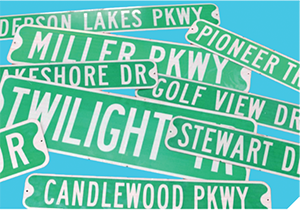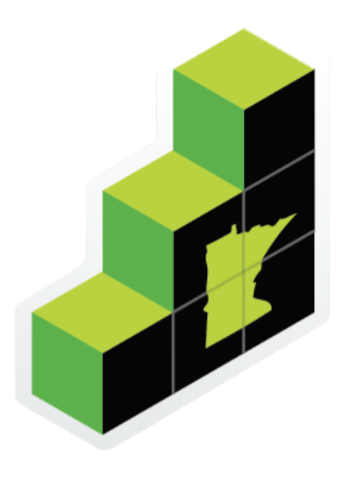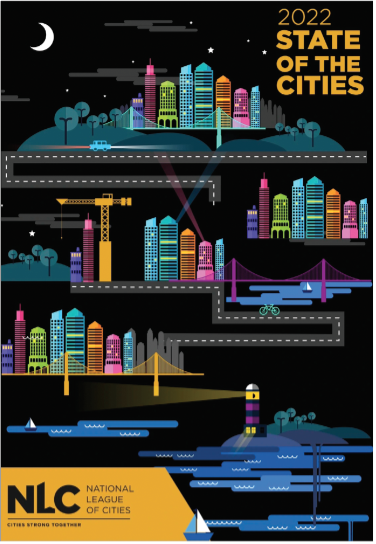Bits & Briefs
A Good Sign For Historic Preservation
 The City of Eden Prairie’s Heritage Preservation Commission is selling decommissioned street signs to raise funds for historical education and preservation efforts. The signs are being retired as part of the city’s compliance with federal retro-reflectability standards, and have become available over the course of a multi-year replacement schedule.
The City of Eden Prairie’s Heritage Preservation Commission is selling decommissioned street signs to raise funds for historical education and preservation efforts. The signs are being retired as part of the city’s compliance with federal retro-reflectability standards, and have become available over the course of a multi-year replacement schedule.
“The street signs are very popular,” said Senior Planner Beth Novak-Krebs. “Some of the more popular signs include Viking Drive, Eden Prairie Road, Flying Cloud Drive, and Pioneer Trail.”
An updated pdf of available stock is posted on the city’s website for buyers to peruse. In addition to the street signs, the commission is selling two books written about the city’s history. While the funds raised can be used for any heritage preservation project, Novak-Krebs said some of the money is earmarked for a public art plaza to display the city’s iconic flying red horse, which once stood on top of a gas station and served as a landmark for decades.
NLC City Summit Slated for Kansas City in November
 The National League of Cities’ (NLC) 2022 City Summit is happening Nov. 16-19 in Kansas City, Missouri. This is an event where city staff and elected officials learn about the issues affecting local governments and expand their professional network. Cities across the country have received historic federal investment and demonstrated the power of local leaders during a crisis. At City Summit 2022, NLC will showcase the impact of local leadership, share best practices, and demonstrate the bold actions that these leaders are taking on behalf of their residents. At this national event, you’ll be able to connect with experts as well as your peers from across the country, and network with thought leaders from the public and private sectors. Learn more and register at http://citysummit.nlc.org.
The National League of Cities’ (NLC) 2022 City Summit is happening Nov. 16-19 in Kansas City, Missouri. This is an event where city staff and elected officials learn about the issues affecting local governments and expand their professional network. Cities across the country have received historic federal investment and demonstrated the power of local leaders during a crisis. At City Summit 2022, NLC will showcase the impact of local leadership, share best practices, and demonstrate the bold actions that these leaders are taking on behalf of their residents. At this national event, you’ll be able to connect with experts as well as your peers from across the country, and network with thought leaders from the public and private sectors. Learn more and register at http://citysummit.nlc.org.
MN GreenStep Cities Offers New Sustainability Index
 Want to find out what local governments in Minnesota are doing about climate change? Check out Minnesota GreenStep Cities’ new Minnesota Sustainability Index, which provides an overview of governmental units in our state that have analyses, goals, and/or plans related to climate, energy, and equity. The index includes local, tribal, regional, and statewide examples and hyperlinks to materials. It tracks local government actions in the following areas:
Want to find out what local governments in Minnesota are doing about climate change? Check out Minnesota GreenStep Cities’ new Minnesota Sustainability Index, which provides an overview of governmental units in our state that have analyses, goals, and/or plans related to climate, energy, and equity. The index includes local, tribal, regional, and statewide examples and hyperlinks to materials. It tracks local government actions in the following areas:
- Energy: Goals related to renewable energy and renewable generation.
- Greenhouse gases and climate mitigation: Greenhouse gas inventories and greenhouse gas reduction goals.
- Planning: Climate action plans, energy action plans, adaptation/resilience plans, and sustainability reports/recommendations.
- Vulnerability and equity: Equity planning/action plans, vulnerable population assessments, and vulnerability/ risk assessments.
- Formal commitments: Commitments to initiatives such as Cities Race to Zero, We Are Still In, and Climate Emergency Declarations.
- Green teams and commissions: Green teams and environmental/sustainability or equity/human rights commissions.
You can do a filtered search of the index to find communities taking the types of actions you’re interested in. Access the index at https://bit.ly/sustainability-index.
National State of the Cities Report
 Despite immense challenges municipal governments have faced in the last two years, the state of America’s cities in 2022 is strong, according to the National League of Cities’ 2022 State of the Cities report, released in June. In the wake of the pandemic, cities have reopened and are rebuilding with the support of unprecedented federal funding from the Bipartisan Infrastructure Law (BIL) and the American Rescue Plan Act (ARPA). These opportunities are reflected in mayoral priorities this year, as cities are finally able to plan the ways they can repair outdated infrastructure and spur economic development.
Despite immense challenges municipal governments have faced in the last two years, the state of America’s cities in 2022 is strong, according to the National League of Cities’ 2022 State of the Cities report, released in June. In the wake of the pandemic, cities have reopened and are rebuilding with the support of unprecedented federal funding from the Bipartisan Infrastructure Law (BIL) and the American Rescue Plan Act (ARPA). These opportunities are reflected in mayoral priorities this year, as cities are finally able to plan the ways they can repair outdated infrastructure and spur economic development.
This year’s State of the Cities report, which highlights the top issues facing America’s cities today, explores the top ways cities plan to use their BIL and ARPA funding to revitalize and reinvest in infrastructure and transportation, equitably grow their local economies, and take new approaches to address public safety, among other priorities. Download the full report at www.nlc.org/resource/state-of-the-cities.
Placemaking Inspiration for Your Rural Community
 The Rural America Placemaking Toolkit is an online resource guide to showcase a variety of placemaking activities, projects, and success stories across rural America. U.S. Department of Agriculture Rural Development has made investments in placemaking since 2020, and entered into a cooperative agreement with the University of Kentucky’s Community & Economic Development Initiative of Kentucky (CEDIK) in 2022 to host the first ever Placemaking in Small & Rural Communities online conference. CEDIK developed this online guide as a way to highlight the importance of placemaking in rural communities, as well as provide comprehensive resources that will be regularly updated to feature new projects, activities, and successes from rural America.
The Rural America Placemaking Toolkit is an online resource guide to showcase a variety of placemaking activities, projects, and success stories across rural America. U.S. Department of Agriculture Rural Development has made investments in placemaking since 2020, and entered into a cooperative agreement with the University of Kentucky’s Community & Economic Development Initiative of Kentucky (CEDIK) in 2022 to host the first ever Placemaking in Small & Rural Communities online conference. CEDIK developed this online guide as a way to highlight the importance of placemaking in rural communities, as well as provide comprehensive resources that will be regularly updated to feature new projects, activities, and successes from rural America.
So, what is placemaking anyway? Placemaking is a comprehensive, intentional approach to community development by exploring what it means for a community to have an identity. Just as a child develops a personality as they grow, places develop a personality as well. Placemaking is a way for community residents to pinpoint what that sense of place is and how to incorporate it in its roads, storefronts, and community activities to celebrate individual cultures within a community as well as a shared identity. If you’re interested in getting started with placemaking in your rural community, the toolkit offers a 5-minute placemaking assessment survey. At the end, you will receive your results and a “toolkit road map” for projects and inspiration that connect to your readiness level. Check out the toolkit at www.ruralplacemaking.com.
Need Help With Community Engagement? Check Out Woodbury’s Toolkit
 As part of efforts to update its urban tree canopy plan, the City of Woodbury worked with others to develop a public engagement toolkit. It is now available for other cities to use for urban forest projects and beyond.
As part of efforts to update its urban tree canopy plan, the City of Woodbury worked with others to develop a public engagement toolkit. It is now available for other cities to use for urban forest projects and beyond.
Woodbury committed to updating its 2011 tree plan as part of the city’s 2040 comprehensive plan. Much of the urban forest grows on private property, and the city recognized that the engagement and commitment of landowners was critical to reach the targeted goals for the overall canopy. To achieve this, the city partnered with students and faculty in the University of Minnesota’s Resilient Communities Project (RCP), as well as the Metropolitan Council. The partnership helped city staff find innovative ways to reach different stakeholders in the community and build relationships with historically underrepresented groups.
The resulting toolkit contains tools for planning and engagement, including an inclusive engagement checklist that can be used for any project. Learn more about the project and access the toolkit at https://conservancy.umn.edu/handle/11299/220178.

